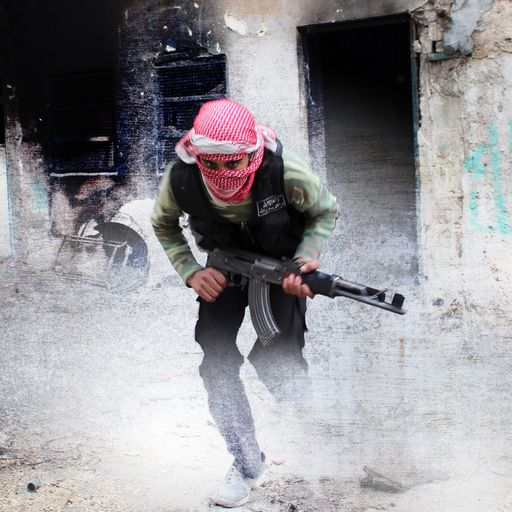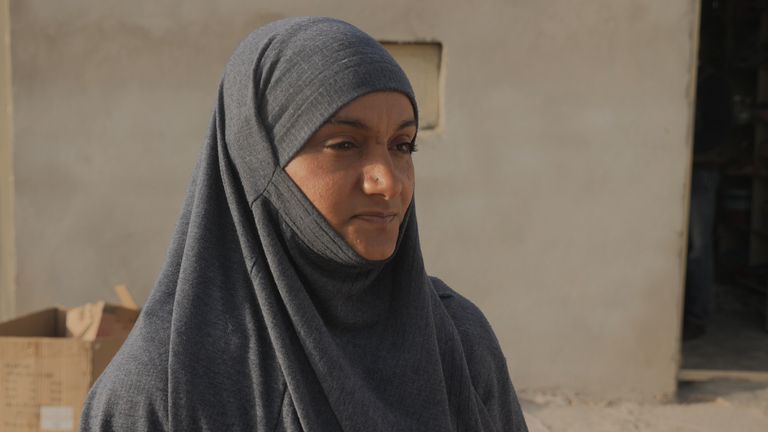After a Decade of War, Syria Has More Horrors in Store
Sky's Mark Stone visits refugee camps in northern Syria and hears of the growing influence of Islamic State inside.
‘My mother forced me to join IS – then they shot me’
We’d been asked into the clinic of a camp called Al Hol to meet a young woman.
Seventeen years old, we were told, and here because she’d been shot.
We are protecting her identity and we have changed her name. She asked us to call her Mona.
If only we could show you her face. It’s one of innocence that was ripped from her when she was just 11.
Married at 11 years old
“I was 11 years old when my mother forced me to marry. I was married to someone who was 24 years old,” she says in a soft voice.
From what we can gather, Mona had a relatively normal childhood until the start of Syria’s brutal conflict in 2011. As Islamic State (IS) extremists swept through the country, they began occupying cities, towns and villages.
Many fled. Many died. And some were drawn in by the extreme religious ideology, either willingly or through coercion.
In Mona’s family, she recalls, it was her elder sibling who first showed a loyalty to IS. Soon after, her mother also turned.
It was in this context that she was offered up by her radicalised mother as a bride to a 24-year-old IS member who served as a judge in one of the terror group’s religious courts in 2015.
“I was with him for three months and then he was killed,” she told us. “I was forced by my mother to be in the Islamic State. But I don’t like them.”
After IS was defeated in early 2019, she and her radicalised mother ended up in the camp where we now find her – Al Hol – in the barren oil-rich plains of north-eastern Syria.
An attempted murder
Al Hol is a holding camp for the women and the children of IS. The men were all taken to local prisons where they remain.
The situation in both the prisons and the camp is the same: a legal limbo where foreigners, who ended up joining IS, now wait while the world wonders what to do with them.
The clinic, a series of portacabins joined together, is the least unpleasant place in the sprawling camp and it is where Mona has been for the past couple of weeks.
She tells us the ideology of IS runs through the camp and that she resisted the extremism which continued to be pushed on her by her mother.
“I complained to the security guards about her. They took her away but she was released and smuggled out of the camp.”
The IS caliphate has been defeated but sleeper cells are still active across parts of Syria and attempts to rebuild a caliphate of sorts within the camp appear to have been successful.
Twelve days ago men came into the tent where Mona and her friends were sleeping.
“I got four bullets in my stomach and leg.”
She shows us the bandage on her waist and then pulled it back to reveal one of the wounds.
“That day I was so scared I hid under my blanket and the bullets came through the blanket. Two people were killed, one was injured, and so was I, and another was unharmed.”
Does she know who did it, I ask?
“It was IS. No one else could do this other than IS. My mother once threatened me and told me that she would send them to shoot me and that they would be wearing masks. Just like my mum said, the Islamic State shot me.”
And then a few words which really hit me: “She’s doesn’t want me, and I don’t want her either.”
Just outside the clinic, the ideology of IS confronts us immediately.
“If Isis returned, I would like to go back,” a woman, clad in black, says.
“It’s a state which teaches the laws of God.”
The rebuilding of the Islamic State
There are 69,000 people in Al Hol. Most of them women and children and many of them utterly committed, still, to their caliphate.
The Syrian-Kurdish authorities who guard the camp take us to what they call “the annex” – where the foreigners are held.
We pass a group of black-clad women with three injured children; two toddlers with plastered arms and one with a bandaged face.
They fell, the woman says, and broke their arms.
As we talk, a stone hits the tin roof above us.
It came from behind. I turn to see a small group of young children lobbing stones at us. A few have slingshots.
“Apostates!” they shout.
Born into this camp, they know nothing except IS. It is indoctrination and it is so terribly sad.
I watch one little boy of about two sitting in the dirt. He’ll need a year or two before he is of an age to throw stones or accuse us of being non-believers.
Instead he plays with a makeshift toy kite – a black bag and a bit of string. This is childhood in Al Hol.
Multiple murders
There’s quiet and emptiness in the camp which belies the mood. Forty people have been killed here this year.
When we had arrived a little earlier in the day, one of the female Kurdish guards has said to us “welcome to the IS camp” before explaining that they had effectively lost control in some sections of this sprawling facility.
Two men were shot dead this morning, she had explained.
And, she said, a Bosnian woman, who renounced IS and tried to escape, was beaten with iron bars by other women.
The next generation of jihadists
The camp annex is home for about 2,000 foreign families from all around the world. There are believed to be a handful of British families here but the authorities have not got a clear grasp of nationalities or indeed who the most extreme women are.
The problem, one of the guards explains, is that many of the women no longer identity themselves with where they are from but instead identity as members of IS.
And all of them are behind black veils and so telling one from another is impossible.
We first visited the camp in November 2019. Back then the authorities were warning that they couldn’t cope, that they needed international help to process the women and children and that they feared the creation of a new caliphate.
Now, their fears have been realised according to Kino Gabriel, a commander and spokesman for the Syrian Democratic Forces who led the defeat of Isis.
“They are implementing Shariah law. They have their own ‘police’, we call it – al Hisba,” he tells us.
He urges the international community to take the issue seriously.
“And it’s all from women who are fuelling this extreme mentality into their children and the young people who are there. If not dealt correctly with, they would create the next generation of jihadists.”
Geopolitical complications
The Syrian-Kurds have taken advantage of the chaos of a decade of conflict in Syria to carve out there own autonomous region in the northeast of the country.
Their role in defeating IS in 2019 was pivotal. But their semi-autonomy has alarmed neighbour Turkey which has long considered them an enemy.
For western nations to support the Kurdish enemy of Nato member Turkey presents a conundrum.
Cynics have suggested that the call for international help is part of a strategy to secure investment in and engagement with a new autonomous Kurdish land.
Kino Gabriel counters: “Chaos on the ground provides IS with the chance to reorganise itself in a better way and try to capture new areas. We have seen IS move very quickly.
“Don’t take our words for it. Come and see for yourself and you will be able to know what is happening.”
Wandering around the camp and watching the children is a deeply upsetting experience.
What on earth will happen to these children? They are clearly from all over the world. They have physical features which place them so many miles from this barren Syrian plain. Blonde hair, black skin, Asian eyes.
A solution?
To the northeast of Al Hol is another camp and a different problem. Roj is where women who appear to be less radical or to have renounced IS are held.
The contrast couldn’t be greater. The mood is a world away from Al Hol.
To start with, the children, who are everywhere, are behaving like children, jumping across a ditch, laughing, playing football with a flat ball and a makeshift pitch.
The camp is a fraction of the size of Hol. There are 2,618 people here, made up of 784 families, 684 of whom are foreign families from 30 different counties.
Strikingly, half the population of Roj camp are children under the age of 12.
I meet a German woman dressed in western clothes with a headscarf. She insists that she isn’t radical. Why should anyone believe her, I ask?
“You can see what I am wearing…” she says. “And my friends back home [in Bremen] will tell you.”
She claims the German government is considering whether to allow her to return. She won’t give us her name and so we can’t check her story.
Just like Al Hol, there is no deradicalisation programme here and no tools or support to provide for such a programme. There is a school though and charities are able to operate here more easily and safely.
In the last year, 295 families have been transferred from Al Hol to Roj in an attempt to separate less extreme women from the most radical.
But the problem is they are all marooned. Whether they be radical IS followers in al Hol or apparently reformed characters in Roj, their countries, by and large, don’t want them back.
Outside the Roj camp shop, I meet a woman who says she is from Russia. She is with her young daughter and is visibly upset.
In broken Arabic, she tells me that she accepts that she’s done wrong by joining the Islamic State. But what about her children, she asks.
It is a message we hear repeatedly during our visit to Roj. “Don’t punish our children for our mistakes”, they say. And they say “just tell us what you will do with us”.
They want their limbo to end, and so too do the Kurdish authorities who don’t have the capacity, the funding or the expertise to deal with such a huge challenge.
The British women
Among the women in Roj camp are twin sisters Zahra and Salma Halane, born in Denmark but raised in Manchester.
In 2014, at 16, they left the UK for Syria to join IS.
They had been held in al Hol but have now been moved to Roj where we met them briefly.
They wouldn’t talk though, saying only that their lawyer, in Denmark, had advised them not to speak to anyone.
We also had the briefest of encounters with Shemima Begum, who left London as a 15-year-old to join IS. Now 21 and stripped of her UK nationality, she too refused to talk to us.
Mona’s future
Back with Mona in the Al Hol clinic, I listen as she tells us about her hopes.
“I want to go back to living a normal life,” she says. “IS destroyed our lives. I don’t want them.”
The doctors tell us she is recovering well from her physical injuries.
Our encounter caught the attention of the authorities and she is now in a safer situation.
The views expressed in this article do not necessarily reflect the views and editorial stance of the SOHR.
















